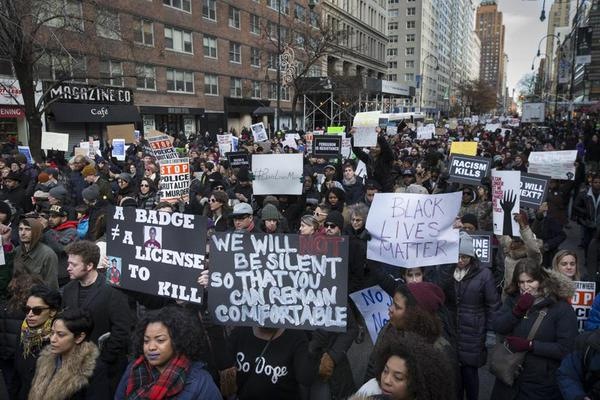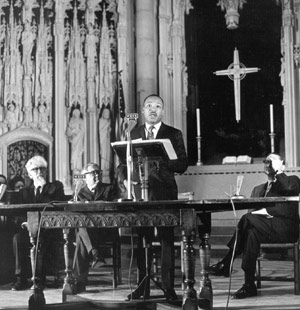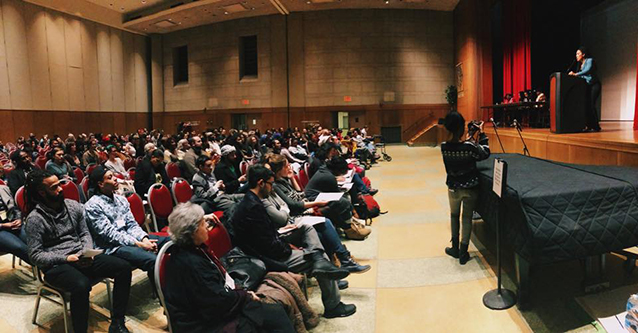by Dan La Botz
February 2, 2015
The Black Lives Matter Movement is alive and well. If it has for the moment—under political attack and facing the winter’s sub-freezing temperatures—withdrawn from the streets, it has done so to plan a new stage in the fight for justice for African American victims of police racism and violence. As many as 400 people, mostly young people of color, attended the eight-hour long Black Lives Matter Gathering at the famous Riverside Church in Manhattan on January 30 where in workshops, trainings, and plenary sessions it seemed that a new direction was being set for the movement.
Looking around the room and at the stage during the plenary, it was apparent that this event signaled a turn in America’s social movements today. While there were people there of all ages, it was clear that this is a movement of the young, and while there were people of all races, it was also clear that this is a movement led by people of color and by African Americans in particular.
 Millions March, New York City, December 13, 2014.
Millions March, New York City, December 13, 2014.
Black women took the lead in organizing the event, in the workshops, and in the plenary, where the dominant themes were the need for organization, program, and strategy. If they admire the Civil Rights Movement of the 1960s, the activists of today’s Black Lives Matter Movement believe they start at a higher political level, committed to full equality for women and the LGBT community. If some of those involved in Black Lives Matter got their first experience with a mass movement in Occupy Wall Street, they seem have now to have drawn the lesson that a movement needs a democratic organization, a list of demands, and a strategy that can organize the power to achieve them. If they still want no traditional leaders, they are interested in creating an inclusive, democratic, and collective leadership.
Most of the activists at the Gathering came from community- or campus-based organizations in the New York City area. And while every anarchist, socialist, or communist group seemed to be in attendance—and there are plenty of them—the most striking thing was the sense that the movement was greater than all of the groups, that it had its own independent life. These activists from the Black Lives Matter Movement in New York, made up of tens of thousands who had participated in protests throughout the city over the last several months, had come together at the Gathering to help the movement to find itself, to know itself, and to figure out where it was going. One had the sense of being present at an historic event, one that marks the beginning of new and significant developments.
The Emergence of a New Social Movement
The Black Lives Matter Movement emerged across the country in the fall of 2014 as thousands of people in scores of cities, organized by local groups or national networks, protested the police killings of Michael Brown in Ferguson, Missouri and Eric Garner in New York City. The December 13 Millions March in New York, a march of 50,000 organized by two young African American women, 19-year-old Synead (Cid) Nichols and 23-year-old Umaara Elliot, was a high point in the movement.
But when on December 20 Ismaaiyl Abdullah Brinsley, a man with a long history of mental illness, first shot and seriously wounded his girlfriend in a Baltimore suburb and then killed two New York City Police Department officers, Rafael Ramos and Wenjian Liu, the situation suddenly changed. The New York police union, a number of politicians, and the media argued that the Black Lives Matter Movement was responsible for the killing and that the protests should stop. When Mayor de Blasio called upon the protestors to pause until after the police officers’ families had held their funerals, the protestors refused. “We will not let recent tragic moments derail this movement,” one protester shouted. “This is the revolution and we will not be repressed.”
Still, the change in the political climate caused by the killings of the police officers and the conservative pro-police and anti-movement rhetoric, combined with the arrival of winter and below-freezing temperatures, drove the movement from the streets. Organizers of the Black Lives Matter Gathering felt that this pause provided a moment for reflection, reorganization, and recommitment to the movement’s goals.
The Gathering

Martin Luther King, Jr. speaks at Riverside Church.
The Riverside Church, the site of many important social justice meetings and where Martin Luther King Jr. made his famous August 4, 1967 speech condemning the Vietnam War, provided space for the Gathering’s 2:00 to 10:00 p.m. program of workshops, trainings, networking sessions, and plenary. The program began with six workshops: Independent Media for the Movement; Organizing Youth to Dismantle Oppression; From Ferguson and NYC to Palestine: Occupation, Racism & Militarized Policing; Running in Heels: Safety Strategies for LGBTSTGNC People of Color; Strategy, Tactics, and Movement Building; and From a History of Repression to a Future Liberation: Where do the Police Come from and How can they be Replaced?
The Strategy, Tactics, and Movement Building Workshop began with about 40 people in the room but ended up with closer to 100. Akua Gyamerah began the discussion by telling those present, “We will need years of patient organizing. We need action, but also need to pause to analyze the situation. We need to ask how we can build, grow, but also how to sustain the movement.” She suggested that the movement needed to be “democratically structured and prepared to engaged in debates about different strategies” in order to draw the lessons of its experiences. When she also argued that the movement needed to be independent of the Democratic Party, the room erupted in applause.
During the discussion speakers—all men and women of color—offered a variety of takes on the state of the movement. One woman talked about the how the Black Lives Matter movement had had a progressive role vis-à-vis the LBGT movement. Another woman was concerned that the various groups in the movement weren’t cooperating. “Right now we are very much fragmented,” she said. One man said, “We need to protest everyday” as well as organizing boycotts. One young woman from a town “up the Hudson,” said she liked the Ferguson idea of being “decentralized but coordinated.” One person argued for organizing around “a few simple demands,” while others thought the movement should be guided by “the needs of society’s most exploited and oppressed.” And there were many other comments and observations. One had to be impressed by the respect speakers showed for each other’s views, though it was also clear that this was only the beginning of what would be a long conversation, and as Gyamerah suggested, there would have to be some serious debate over strategies, goals, and vision.
The sense that African American people have played and continue to play an important role and often the leading role in American history was a pervasive notion. Many speakers both in the workshops and in the plenary argued that when black people move, others usually move with them and that that is generally good for the country, that it leads to greater democracy and more power for working people.
Moral Assignment of the Time: Revolution
The plenary session speakers were five black women: the chair, Prof. Johanna Fernández of Baruch College; Danette Chavis, a founder of National Action against Police Brutality; Ansha Rose a 20 year old activist in the Black Youth Project; Thenjiwe McHarrison of Ferguson Action; and Colia Clark, a veteran civil rights activist and Green Party candidate for the U.S. Senate in 2010 and 2012. The four movement leaders—all of them powerful speakers—were asked by Fernandez to respond to the questions at the center of the Gathering: What is this movement? What do we learn from the past? Where do we go from here? What do we need to grow and win?
Chavis argued that the police had to be held accountable for their actions. “This is not the 1960s all over again. Then there was a demand for laws, today we have the laws and they are being broken.” She told the nearly 400 people at the plenary session, “Something totally different is taking place in law enforcement today. Ever since the Twin Towers dropped, things have changed. Rights have been diminished. Muslims have been persecuted.” Since September 11, 2001, she argued, in the eyes of government and the police, “the American people have become the potential terrorists.” Chavis told the young activists, “In this fight all hands are needed. Protest. Boycott. We need to do it all. Hit ‘em high, hit ‘em low.”
 The plenary session at the gathering. Image from event Facebook page.
The plenary session at the gathering. Image from event Facebook page.
Ansha Rose told the group, “We have to dispel the myth that police keep people safe. They keep some people with property safe and protect some people in government. But policing is discriminatory and used to control people.” She also urged people to consider not only police violence but also “structural violence” in every aspect of the social system. To oppose such violence, she said, “We need direct action; that is, confronting power outside of the prescribed channels.” Rose told the group that it was important to be in an organization. “Organizations last longer than movements, longer than campaigns, they sustain us through our lives,” said Rose. She also argued for the importance of making demands. “We need specific demands—and a step-by-step strategy to take power and to win our demands.”
When Rose dismissed the notion that we live in a “post-racial society,” and criticized those who carried “All Lives Matter” signs in the Black Lives Matter demonstrations, there was applause from the crowd. “We have to fight to say ‘Black Lives Matter’ even in this movement,” she said. “I believe in solidarity and in allies, but the word ‘ally’ should be a verb. We need to have a discussion about what it means to be an ally, and to be able to listen to each other.”
Thenjiwe Harris, who has been active in Ferguson, told the group, “I didn’t need a police union official to tell me they were going to make war on us. When they militarized the police, that told me that there was a war against our people. Today militarized weapons are in our communities and in our schools. In Ferguson they came out with everything they have. They will do it everywhere when the time is right. So we have to bring them everything we’ve got. The time for sitting on the sidelines is over, the question is: which side are you on?”
Colia Clark, a veteran of the Student Nonviolent Coordinating Committee (SNCC), began by saying that when she saw this new movement and couldn’t identify any leaders, she thought to herself, “that’s like SNCC.” Clark talked about American history, arguing that, “The United States is not and has never been a democracy.” For just that reason, she argued, we need to call for a Constitutional Convention to re-found the country. But before that, she told the Gathering, “We need to call a convention of the 800 cities that joined the Black Lives Matter protests.”
Johanna Fernandez ended the plenary session by stating, “The moral assignment of this time is to bring revolution to this nation.”
The Black Lives Matter Gathering was a signal event. No doubt it is only one of many such events large and small taking place across the country. The Gathering made clear that we not only have a new movement here, but that there is a new leadership. We are at the beginning of something big and important.
Dan La Botz is an editor of New Politics, where this article originally appeared, and a member of Solidarity in New York City.

Comments
One response to “Black Lives Matter Gathering Points to a New Direction for the Movement”
I’ve been a part of numerous activist movements in my 88 years of life, and Black Lives Matter gives me reason to hope that this one may have the staying power to turn this country around.